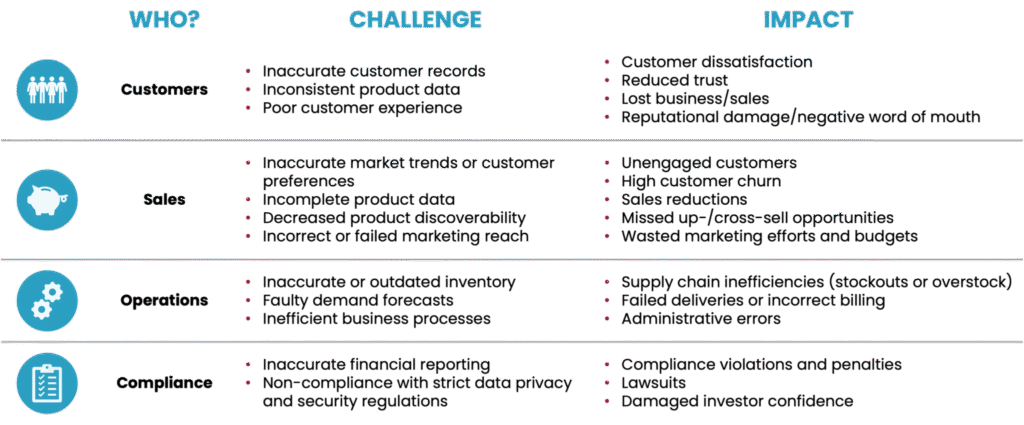When was the last time you really took a hard look at the quality of your data? It is stated so often that it sounds almost cliché, but data really is critical in making reliable decisions. Therefore, it stands to reason if the data is not reliable, then the decision cannot be reliable either.
Does data quality, or lack of, really affect me?
First, let’s start off with a basic definition. What is data quality? In simplest terms, data quality refers to the overall accuracy, completeness, reliability, consistency, and relevancy of data. Is the data free from errors? Is there a consistency across multiple sources? And do you have all the attributes?
I hear CIOs and other executives often say, “we are getting by” or “that is not a top priority”. The challenge is determining if data quality may be an issue. So, let’s look at some very simple signs you may have a data quality issue.
- Low internal and external business stakeholder confidence:
- If stakeholders within your organization express low confidence in the data being used for decision-making or question the accuracy and reliability of the data, it may suggest data quality concerns. And if they do not trust the data, they will hesitate in making decisions. Or even worse, make wrong decisions that negatively impact business outcomes.
- If customers or users identify discrepancies or inaccuracies in the information they receive from your organization, it may indicate data quality problems. Examples are billing issues, incorrect customer information, and inaccurate product information.
- Inaccurate or inconsistent reporting:Do you find your reports consistently produce incorrect or conflicting results? Discrepancies or errors in the data used for reporting can indicate underlying problems with data accuracy, completeness, or consistency.
- Poor data integration or data matching:Today, you typically have multiple sources of customer, employee, and product data. Incomplete or inconsistent data across different systems or databases can hinder data integration efforts and compromise the accuracy and reliability of consolidated information. This leads to frustration and loss of productivity.
- Questionable audit findings:Hopefully this information comes about as a proactive internal effort that helps identify data quality issues. But at times, external audits can reveal data quality issues. If your audits reveal significant data discrepancies or errors, it indicates the presence of data quality problems that require attention and remediation.
So, I may have a data quality problem… is there really a significant impact on my business?
Quite possibly YES and here are some examples.

How do I get started? What are the first steps?
- Clearly define specific goals and metrics to measure and monitor data quality. Make sure your data quality aligns with the organization’s overall strategic objectives.
- Assess the current state of data quality within your organization. Identify data quality issues, gaps, and potential sources of poor data quality. This assessment serves as a baseline for improvement efforts.
- Identify specific data quality issues that need to be addressed. This could involve analyzing reports, conducting data quality assessments, and gathering feedback from stakeholders. Prioritize the issues based on their impact on business processes, decision-making, and customer satisfaction.
- Define clear and measurable data quality metrics to assess and monitor the identified issues. Metrics could include measures of accuracy, completeness, consistency, timeliness, and validity. These will serve as benchmarks for you to evaluate progress and track improvements over time.
By recognizing the importance of data quality and investing in data quality management processes, you can improve decision-making, operational efficiency, customer satisfaction, and compliance while deriving maximum value from your data assets. With accurate data, you can uncover trends, patterns, and correlations that drive strategic decision-making, optimize processes, and identify growth opportunities.
Imagine realizing these real-world outcomes for your business:
- Optimize operating costs by 13% and drive a 27% cross-/up-sell via global cloud-based data management modernization.
- Reduce customer search time by 83%, resulting in 30% larger average purchases via central repository of trusted product information.
- Remediate data quality issues to enable improved decision making and reduce errors by 55%, saving $5M.
- Eliminate audit fines by $750K+ and reduce month-/quarter-end processes by 75% via single 360° view of tax data.
If you would like to learn more about how we’ve helped many companies achieve the real business value above, request a consultation to learn more about the Power of Paradigm.

Kevin Holdefer, Strategic Solutions Executive
Kevin.Holdefer@pt-corp.com | 205-585-1297

